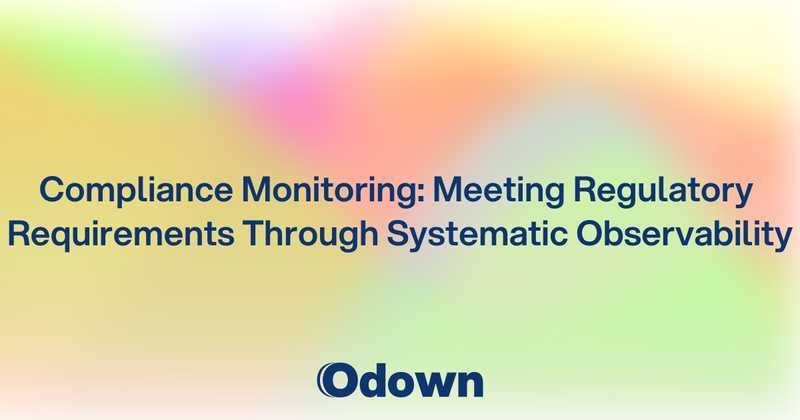Compliance Monitoring: Meeting Regulatory Requirements Through Systematic Observability
Your company just received a regulatory audit notice, and the auditors want detailed logs showing who accessed what data when---but your monitoring system doesn't capture the granular access patterns they need. Your HIPAA compliance team discovered that patient data was accessible through an unsecured API endpoint for three weeks, but your monitoring failed to detect the vulnerability. Your GDPR compliance officer needs proof that personal data requests are being processed within required timeframes, but your current monitoring doesn't track data processing workflows.
Regulatory compliance increasingly depends on comprehensive monitoring and audit trails that many organizations realize they need only when facing audits, investigations, or compliance violations. Traditional monitoring focused on performance and availability often misses the detailed access logs, data handling records, and process documentation that regulators require.
Compliance monitoring must be built into systems from the beginning rather than added after problems arise. Retroactive compliance documentation is expensive, unreliable, and often insufficient to satisfy regulatory requirements.
Professional monitoring platforms provide the foundation for compliance monitoring by ensuring that regulatory reporting systems, compliance dashboards, and audit trail platforms remain accessible when auditors need them. But comprehensive compliance monitoring requires systematic approaches to data collection, retention, and reporting that support regulatory requirements across different frameworks.
Regulatory Monitoring Requirements: GDPR, HIPAA, SOX, and Industry Standards
Different regulatory frameworks require specific monitoring capabilities and documentation approaches that organizations must understand and implement systematically.
GDPR Data Protection Monitoring
The General Data Protection Regulation requires extensive monitoring of personal data processing activities:
Data processing activity monitoring tracks when personal data is collected, processed, stored, and deleted. GDPR requires organizations to document all processing activities and demonstrate compliance with data protection principles.
Consent management monitoring ensures that user consent is properly collected, recorded, and respected throughout data processing activities. Consent monitoring must track opt-ins, opt-outs, and consent withdrawal across all systems and touchpoints.
Data subject rights fulfillment monitoring tracks how quickly and accurately organizations respond to data access requests, deletion requests, and data portability requests. GDPR requires specific response timeframes that must be monitored and documented.
HIPAA Healthcare Compliance Monitoring
Healthcare organizations must monitor access to protected health information and demonstrate security safeguards:
PHI access monitoring logs all access to protected health information, including who accessed what data when and for what purpose. HIPAA requires detailed access logs that can identify unauthorized access or data breaches.
Security incident detection and response monitoring tracks potential data breaches and ensures that incidents are detected, investigated, and reported within required timeframes. HIPAA breach notification requirements have strict timing requirements.
Business associate monitoring ensures that third-party vendors and partners comply with HIPAA requirements when handling PHI. Business associate agreements require monitoring to verify ongoing compliance.
SOX Financial Reporting Monitoring
Sarbanes-Oxley compliance requires monitoring of financial reporting systems and controls:
Financial system access monitoring tracks who can access and modify financial data and reporting systems. SOX requires strong controls over financial information that must be monitored and documented.
Change management monitoring ensures that modifications to financial systems follow approved processes and are properly documented. SOX requires evidence that financial system changes are controlled and authorized.
Control effectiveness monitoring validates that internal controls are operating effectively and identifies control failures that could affect financial reporting accuracy. Control monitoring must be ongoing and documented for auditors.
Compliance Automation: Monitoring-Driven Regulatory Reporting
Automated compliance reporting reduces manual effort while improving accuracy and consistency of regulatory documentation.
Automated Data Collection and Aggregation
Compliance reporting requires systematic data collection from multiple sources:
Multi-system log aggregation collects compliance-relevant data from applications, databases, security systems, and infrastructure components. Centralized log aggregation ensures comprehensive compliance coverage and simplifies reporting.
Real-time compliance dashboard creation provides ongoing visibility into compliance status and identifies potential violations before they become serious problems. Real-time monitoring enables proactive compliance management.
Exception reporting automation identifies activities that deviate from compliance policies and require investigation or remediation. Exception reporting helps compliance teams focus on the most important issues.
Regulatory Report Generation
Automated reporting reduces the burden of compliance documentation:
Scheduled compliance report generation creates required regulatory reports automatically based on monitoring data. Automated reporting ensures consistency and reduces the risk of human error in compliance documentation.
Audit-ready documentation compilation organizes monitoring data into formats that auditors expect and require. Audit-ready documentation saves time during audits and demonstrates proactive compliance management.
Regulatory submission automation can directly submit required reports to regulatory agencies when appropriate. Automated submission ensures timely compliance and reduces administrative overhead.
Policy Compliance Validation
Automated monitoring can validate compliance with organizational policies and regulatory requirements:
Policy violation detection identifies activities that violate established compliance policies and trigger investigation workflows. Automated policy enforcement helps prevent compliance violations before they occur.
Control testing automation validates that compliance controls are working effectively and identifies control failures that require attention. Automated control testing provides ongoing assurance of compliance effectiveness.
Risk assessment automation evaluates compliance monitoring data to identify trends and patterns that indicate increased compliance risk. Risk assessment helps organizations focus compliance efforts on the most important areas.
Audit Trail Creation: Documentation and Evidence Collection for Compliance
Comprehensive audit trails provide the evidence that auditors and regulators need to verify compliance with applicable requirements.
Comprehensive Activity Logging
Effective audit trails capture all activities relevant to compliance requirements:
User activity logging records who performed what actions when and from where. User activity logs must be comprehensive, tamper-proof, and searchable to support audit and investigation requirements.
System change documentation tracks all modifications to systems, configurations, and data. Change documentation must include who made changes, when changes occurred, and why changes were necessary.
Data access and modification tracking logs all access to sensitive data and tracks any modifications or deletions. Data access logs must be detailed enough to support investigations and demonstrate compliance with data protection requirements.
Tamper-Proof Evidence Collection
Audit trails must be protected from modification to maintain their value as evidence:
Immutable log storage ensures that audit trail data cannot be modified after creation. Immutable storage provides confidence that audit evidence is reliable and authentic.
Digital signature and hash verification validates the integrity of audit trail data and detects any unauthorized modifications. Cryptographic verification provides strong evidence of audit trail authenticity.
Secure backup and retention policies ensure that audit trail data is preserved for required retention periods and remains accessible for audits and investigations. Secure retention protects audit evidence from loss or destruction.
Evidence Organization and Retrieval
Audit trails must be organized to support efficient retrieval during audits and investigations:
Searchable audit databases enable rapid retrieval of specific audit evidence based on various criteria. Searchable databases help auditors find relevant evidence quickly and efficiently.
Timeline reconstruction capabilities help investigators understand the sequence of events during incidents or compliance violations. Timeline reconstruction is often critical for understanding causation and responsibility.
Evidence correlation analysis links related audit trail entries to provide comprehensive views of complex activities or incidents. Correlation analysis helps auditors understand the full scope of activities and their compliance implications.
Risk Management Through Monitoring: Proactive Compliance and Risk Mitigation
Effective compliance monitoring enables proactive risk management that prevents violations rather than just detecting them after they occur.
Risk Indicator Monitoring
Proactive compliance monitoring tracks leading indicators that predict potential compliance problems:
Compliance trend analysis identifies patterns that indicate increasing compliance risk before violations occur. Trend analysis enables proactive intervention to prevent compliance problems.
Early warning system development uses monitoring data to alert compliance teams when activities approach compliance thresholds or violate policy guidelines. Early warnings enable corrective action before violations occur.
Risk score calculation combines multiple monitoring metrics to provide overall compliance risk assessments. Risk scores help compliance teams prioritize attention and resources on the highest-risk areas.
Preventive Control Monitoring
Monitoring can validate that preventive controls are working effectively:
Access control effectiveness monitoring verifies that security controls prevent unauthorized access to sensitive systems and data. Access control monitoring demonstrates that preventive measures are working as intended.
Data loss prevention monitoring tracks attempts to transfer sensitive data outside authorized channels and validates that DLP controls are effective. DLP monitoring provides evidence of data protection effectiveness.
Configuration drift monitoring detects when systems drift from approved security configurations that support compliance requirements. Configuration monitoring prevents compliance violations due to security control degradation.
Continuous Improvement Through Monitoring
Compliance monitoring data provides insights that support ongoing improvement:
Compliance performance metrics track how well organizations meet compliance requirements over time and identify areas for improvement. Performance metrics help demonstrate compliance program effectiveness.
Best practice identification analyzes monitoring data to identify approaches that consistently produce good compliance outcomes. Best practice identification helps organizations optimize compliance processes.
Training needs assessment uses compliance monitoring data to identify areas where additional training or awareness might prevent future violations. Training needs assessment helps organizations invest training resources effectively.
Compliance monitoring requires reliable infrastructure to ensure that regulatory reporting systems remain available when needed. Customer experience monitoring strategies provide relevant frameworks for measuring the business impact of compliance-related system performance.
Ready to ensure your compliance monitoring systems and regulatory reporting platforms remain reliable and accessible? Use Odown to monitor the websites, dashboards, and APIs that support your compliance programs, ensuring that audit trails and regulatory reports remain available when auditors and regulators need them.



